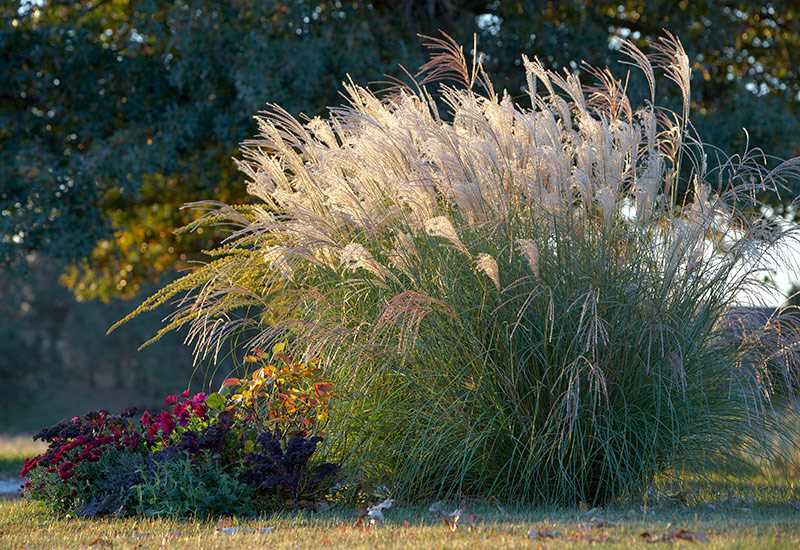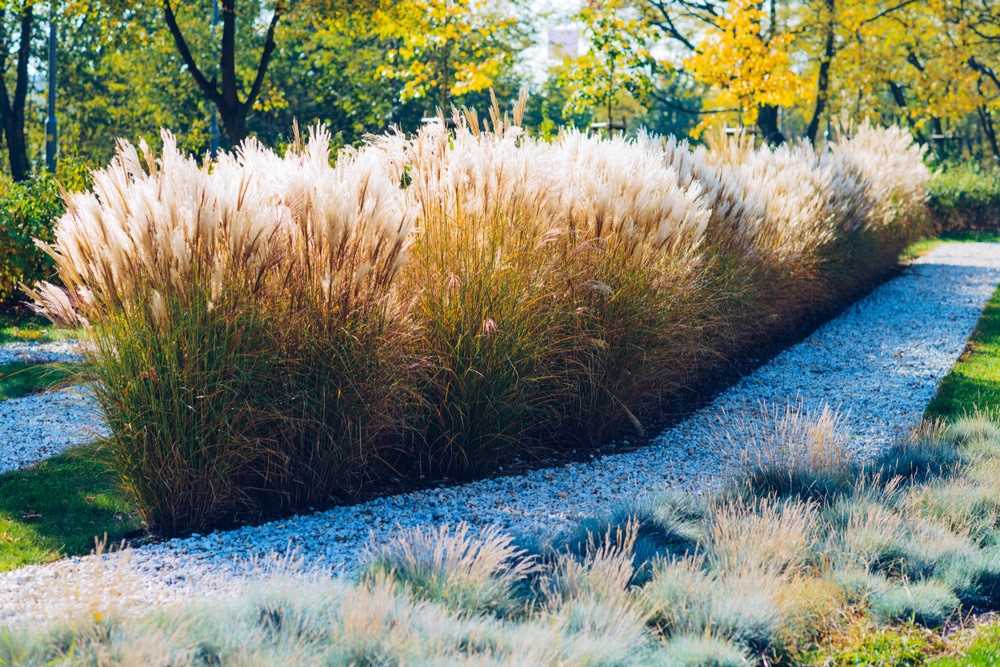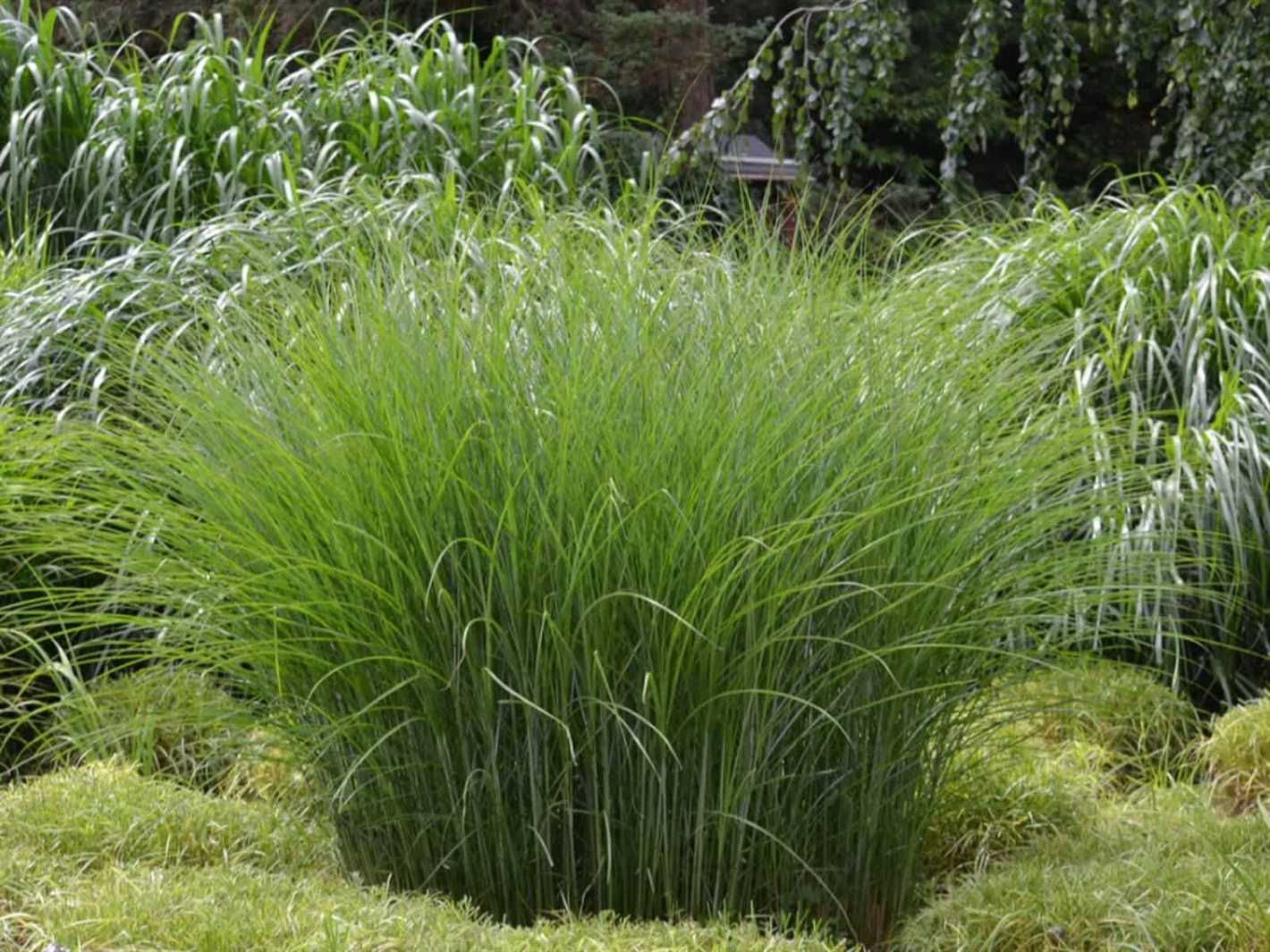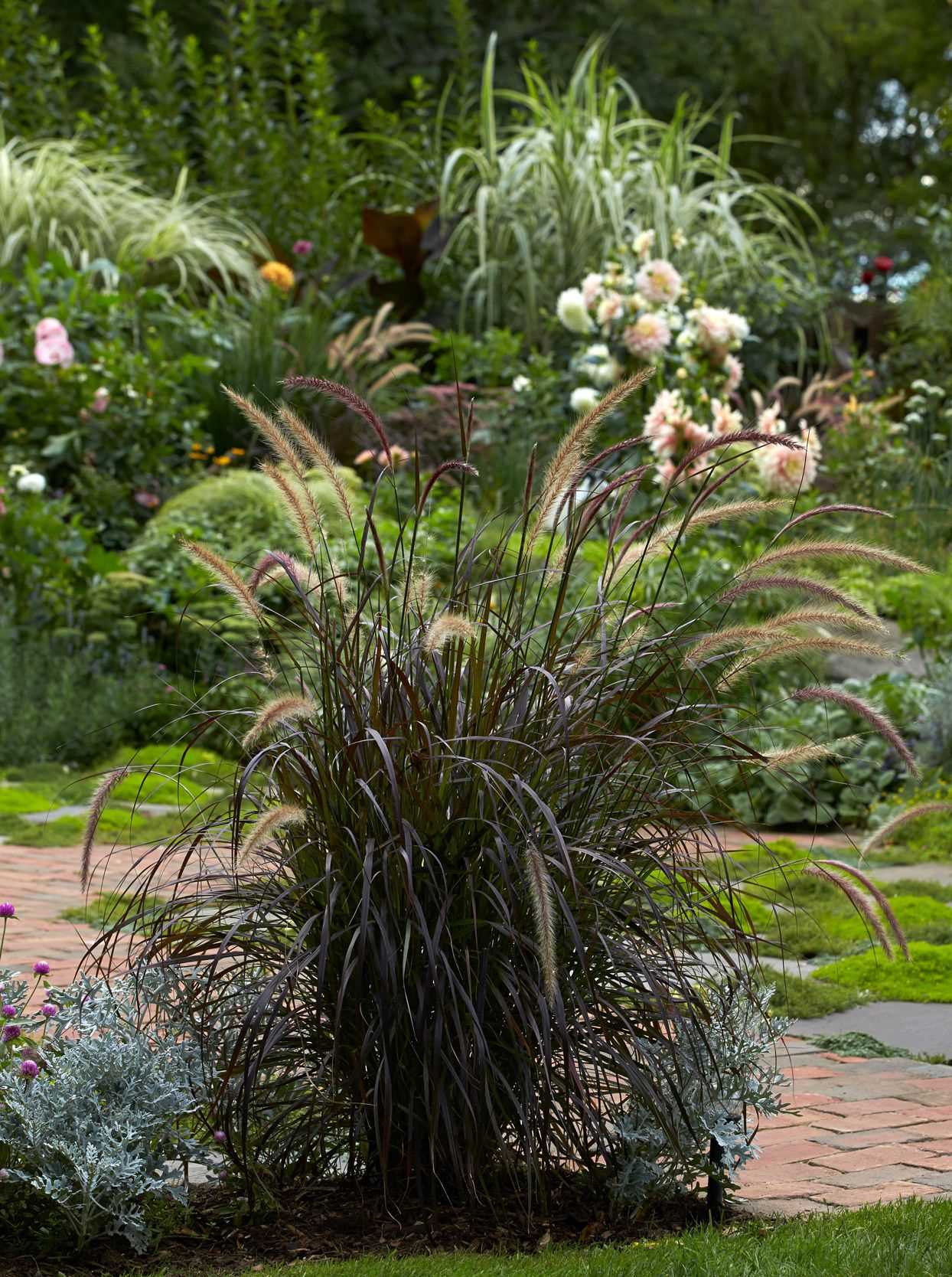- Getting Started with Miscanthus
- Choosing a Variety
- Preparing the Soil
- Planting and Maintenance
- Controlling Spread
- Winter Care
- Uses of Miscanthus
- Conclusion
- Choosing the Right Miscanthus Variety
- 1. Climate
- 2. Height
- 3. Spread
- 4. Flower Color
- 5. Fall Color
- 6. Soil and Sun Preferences
- 7. Maintenance
- How to Plant Miscanthus
- Choosing the Right Location
- Preparing the Soil
- Spacing
- Planting the Miscanthus
- Maintenance
- Conclusion
- Growing and Caring for Miscanthus
- Site Selection
- Planting
- Watering
- Fertilizing
- Pruning
- Winter Care
- Pruning and Maintenance Tips for Miscanthus
- 1. Pruning
- 2. Division
- 3. Maintenance
- 4. Winter Care
- Potential Pests and Diseases of Miscanthus
- Pests
- Diseases
- Conclusion
- Uses for Miscanthus in the Garden
- 1. Privacy screening
- 2. Ornamental grass bed
- 3. Border plant
- 4. Erosion control
- 5. Wildlife habitat
- 6. Dried flower arrangements
- 7. Biomass production
- Harvesting and Propagating Miscanthus
- Harvesting Miscanthus Seeds
- Propagating Miscanthus through Division
- Questions and Answers:
- What is Miscanthus?
- What are some popular types of Miscanthus?
- How do I grow Miscanthus in my garden?
- Can Miscanthus be used as a screening plant?
- Are there any special care requirements for Miscanthus?
- What are some alternative uses for Miscanthus?
- Videos: Planting the Most Glorious Ornamental Grasses!!! // Garden Answer
Welcome to our guide on Miscanthus, a versatile and beautiful ornamental grass that can add texture and interest to any garden. Whether you’re a seasoned gardener or just getting started, Miscanthus is a fantastic choice for your landscape. In this guide, we’ll provide you with tips on how to successfully grow and care for Miscanthus, as well as explore the various types and varieties available.
Miscanthus, also known as maiden grass, is a perennial grass native to Asia. It’s prized for its elegant arching foliage and showy plumes that add height and movement to garden beds and borders. With their feathery texture and varying colors, Miscanthus can provide a dynamic backdrop to other flowering plants or serve as a focal point on their own. Whether you’re looking to create a vibrant garden or a serene retreat, Miscanthus is a versatile plant that can fit any style.
To successfully grow Miscanthus, it’s important to choose the right location and provide proper care. Miscanthus thrives in full sun but can also tolerate partial shade. It prefers well-drained soil and is relatively drought-tolerant once established. Regular watering during the first year will help establish deep roots, but be careful not to overwater, as excessive moisture can lead to root rot. Miscanthus is a low-maintenance plant that requires minimal pruning, usually limited to removing dead or damaged foliage in early spring.
TIP: To prevent self-seeding and maintain tidy growth, it’s recommended to remove the plumes before they mature and release seeds.
There are several popular types and varieties of Miscanthus to choose from, each with its own distinct characteristics. ‘Morning Light’ is a popular cultivar with variegated foliage that features thin white stripes, adding a bright and airy feel to the garden. ‘Gracillimus’ is another popular variety, known for its narrow green leaves and gracefully arching habit. ‘Strictus’ stands out with its bold horizontal golden bands, while ‘Zebrinus’ features more pronounced vertical yellow bands that resemble zebra stripes.
Whether you’re looking to add structure, movement, or visual interest to your garden, Miscanthus is a versatile and stunning choice. With its wide range of types and varieties, there’s a Miscanthus plant that will complement any landscape. So, get ready to embark on a gardening adventure and enjoy the beauty and benefits that Miscanthus can bring to your outdoor space.
Getting Started with Miscanthus

Are you interested in growing Miscanthus in your garden? This versatile ornamental grass is known for its elegant beauty and ability to add height and texture to any landscape. Whether you’re a beginner or an experienced gardener, here are some tips to help you get started with Miscanthus:
Choosing a Variety
- There are several different varieties of Miscanthus to choose from, each with its own unique characteristics. Some popular options include Miscanthus sinensis, miscanthus giganteus, and miscanthus transmorrisonensis.
- Consider factors such as the height, color, and flowering time of the variety when selecting which one to grow in your garden.
Preparing the Soil
- Before planting Miscanthus, it’s important to prepare the soil properly. This grass prefers well-draining soil, so be sure to amend the soil with organic matter such as compost to improve its texture and drainage.
- Test the soil pH and adjust it if necessary to ensure the optimal growing conditions for Miscanthus.
Planting and Maintenance
- Plant your Miscanthus in a location that receives full sun or light shade. This grass thrives in bright, sunny areas with at least six to eight hours of direct sunlight per day.
- Space the plants according to the specific variety’s recommendations to allow them enough room to grow and spread.
- Water the newly planted Miscanthus regularly during its first growing season to help establish a strong root system. Once established, Miscanthus is relatively drought-tolerant and only needs occasional watering.
- Apply a slow-release fertilizer in the spring to provide the necessary nutrients for healthy growth.
- Remove any dead or damaged stems in the early spring before new growth appears.
Controlling Spread
It’s important to note that some varieties of Miscanthus can be invasive. To prevent the grass from spreading uncontrollably, consider planting it in containers or using a root barrier to contain its growth.
Winter Care
In colder climates, Miscanthus can benefit from some winter protection. Cut back the grass to about six inches above the ground in late winter or early spring to allow for new growth. Mulching around the base of the plants can also help provide insulation during the winter months.
Uses of Miscanthus

Miscanthus has a variety of uses in the garden and beyond. Consider using it as a focal point in a mixed perennial border, as a hedge or screen, or as a backdrop for other plants. Additionally, Miscanthus can also be harvested and used as a renewable energy source or as a material for crafts and weaving.
Conclusion
Miscanthus is a stunning addition to any garden, and with the right care and maintenance, it can thrive and provide beauty year after year. By selecting the right variety, preparing the soil, and providing proper care, you can enjoy the benefits of this ornamental grass for years to come.
Choosing the Right Miscanthus Variety
If you’re considering adding Miscanthus to your garden, it’s important to choose the right variety for your specific needs and growing conditions. Here are some factors to consider when selecting a Miscanthus variety:
1. Climate

Miscanthus is a hardy and adaptable plant, but different varieties have different climate preferences. Some varieties thrive in cooler climates, while others prefer warmer conditions. Consider your local climate and choose a variety that is well-suited to your region.
2. Height
Miscanthus comes in various heights, ranging from dwarf varieties that grow only a few feet tall to towering giants that can reach heights of up to 12 feet or more. Think about how tall you want your Miscanthus to grow and choose a variety accordingly.
3. Spread
Not only do Miscanthus plants vary in height, but they also have different spreading habits. Some varieties form compact clumps, while others have a more spreading growth habit. Consider the available space in your garden and choose a variety that will fit well without becoming invasive.
4. Flower Color
Miscanthus produces attractive feathery plumes that add visual interest to the garden. These plumes come in a range of colors, including creamy white, silver, pink, and burgundy. Choose a variety with plume colors that complement your garden design.
5. Fall Color
Many Miscanthus varieties offer beautiful fall foliage. The leaves can turn shades of red, orange, and yellow, adding a pop of color to your autumn landscape. Consider the fall color of the variety you’re considering to enhance the seasonal appeal of your garden.
6. Soil and Sun Preferences
While Miscanthus is generally tolerant of different soil conditions and light levels, some varieties may have specific preferences. Evaluate the soil type and light levels in your garden and choose a variety that will thrive in those conditions.
7. Maintenance
Lastly, consider the maintenance requirements of the Miscanthus variety you’re considering. Some varieties may require regular pruning or dividing to control their size or prevent them from becoming invasive. Choose a variety that fits your desired level of maintenance.
By taking these factors into account, you can choose the perfect Miscanthus variety that will thrive in your garden and enhance its beauty throughout the seasons.
How to Plant Miscanthus
Choosing the Right Location
When planting miscanthus, it is important to choose the right location for optimal growth. Miscanthus plants prefer full sun but can tolerate partial shade. Ensure the area has well-draining soil to prevent waterlogging.
Preparing the Soil
Prepare the soil before planting by removing any weeds, rocks, or debris. Loosen the soil with a garden fork to improve drainage and create a good planting environment for the miscanthus plants.
Spacing
It is important to give the miscanthus plants enough space to grow. The spacing will depend on the variety you are planting. Typically, space the plants about 3 to 5 feet apart to allow for proper air circulation and growth.
Planting the Miscanthus
- Dig a hole that is twice the size of the root ball of the plant.
- Place the plant in the hole, making sure the top of the root ball is level with the soil surface.
- Backfill the hole with soil, firming it gently around the plant to remove any air pockets.
- Water the plant thoroughly after planting to help settle the soil.
Maintenance
Miscanthus plants are relatively low-maintenance once established. However, there are a few things you can do to ensure their growth and health:
- Water the plants regularly, especially during dry periods, to keep the soil evenly moist.
- Apply a layer of mulch around the plants to help retain moisture, suppress weeds, and regulate soil temperature.
- Prune the dead or damaged stems in early spring before new growth emerges.
Conclusion
Planting miscanthus can be a rewarding addition to your garden or landscape. By choosing the right location, preparing the soil, and giving the plants proper care, you can enjoy the beauty and benefits of these ornamental grasses.
Growing and Caring for Miscanthus
Miscanthus is a popular ornamental grass that is easy to grow and care for in your garden. Follow these tips to ensure a healthy and thriving Miscanthus plant:
Site Selection

- Choose a sunny location for planting Miscanthus. It thrives in full sun, although it can tolerate partial shade.
- Ensure that the soil is well-draining to prevent waterlogged roots.
- Consider the mature size of the Miscanthus variety you are planting and provide enough space for it to grow without overcrowding other plants.
Planting
- Prepare the planting area by removing any weeds and loosening the soil.
- Dig a hole that is slightly larger and deeper than the root ball of the Miscanthus plant.
- Place the plant in the hole, making sure that it is at the same depth as it was in the container or nursery bed.
- Backfill the hole with soil, firming it gently around the roots to remove any air pockets.
- Water the plant thoroughly after planting to settle the soil and help the roots establish.
Watering
- Miscanthus is drought-tolerant once established, but it benefits from regular watering during the first growing season.
- Water deeply and infrequently, allowing the soil to dry out slightly between waterings.
- Avoid overwatering, as Miscanthus does not tolerate wet feet.
Fertilizing
- Apply a balanced slow-release fertilizer in early spring to promote healthy growth.
- Avoid using excessive amounts of fertilizer, as this can lead to weak and floppy growth.
Pruning
- In late winter or early spring, cut back the previous year’s growth to about 6-8 inches above the ground.
- This will help to rejuvenate the plant and promote fresh growth in the upcoming season.
- Remove any dead or damaged foliage throughout the year to maintain a tidy appearance.
Winter Care
- Miscanthus is generally hardy and can withstand winter temperatures.
- However, in colder regions, it is recommended to mulch around the base of the plant in late fall to provide some insulation and protection from freezing temperatures.
- Remove the mulch in early spring to allow for new growth.
By following these guidelines, you can enjoy the beauty and elegance of Miscanthus in your garden for many years to come.
Pruning and Maintenance Tips for Miscanthus
1. Pruning
Miscanthus plants benefit from regular pruning to maintain their shape and promote healthy growth. Pruning should be done in early spring before new growth begins.
Here are some tips for pruning Miscanthus:
- Use sharp shears or a pruning saw to cut back the plants to a height of around 6 to 12 inches above the ground.
- Remove any dead or damaged stems, as well as any old growth from the previous year.
- Avoid pruning too late in the spring, as this can delay new growth.
2. Division
Miscanthus plants tend to form large clumps over time, and dividing them every few years can help maintain their vigor and prevent overcrowding.
Follow these steps to divide your Miscanthus plants:
- Dig up the entire clump using a garden fork or shovel, being careful not to damage the roots.
- Shake off any excess soil to expose the rhizomes.
- Using a sharp knife or garden pruners, divide the clump into smaller sections, ensuring that each section has a good portion of rhizome and foliage.
- Replant the divided sections in a well-prepared planting hole, spacing them at least 3 to 4 feet apart.
- Water the newly divided plants thoroughly and continue to water regularly until they are established.
3. Maintenance
In addition to pruning and division, there are a few other maintenance tasks to keep your Miscanthus plants healthy and thriving:
- Water regularly, especially during dry spells, to keep the soil consistently moist but not waterlogged.
- Apply a layer of organic mulch around the base of the plants to conserve moisture, suppress weeds, and regulate soil temperature.
- Fertilize in early spring with a balanced slow-release fertilizer to provide nutrients for vigorous growth.
- Monitor for pests and diseases, such as aphids or fungal infections, and take appropriate measures to control them.
4. Winter Care
Miscanthus plants are generally hardy and can withstand cold winter temperatures. However, some additional care may be needed in regions with severe winter conditions:
- In late fall, after the first frost, cut back the foliage of the Miscanthus plants to a height of about 6 inches above the ground.
- Cover the base of the plants with a layer of mulch or straw to provide insulation and protect the roots from freezing.
- In areas with heavy snowfall, gently brush off any accumulated snow from the plants to prevent damage.
By following these pruning and maintenance tips, you can enjoy the beauty and longevity of your Miscanthus plants for many years to come.
Potential Pests and Diseases of Miscanthus
Miscanthus is generally a hardy and low-maintenance plant, but like any other plant species, it can be susceptible to certain pests and diseases. It is important to be aware of these potential issues in order to prevent and manage them effectively.
Pests
Aphids: Aphids are small insects that feed on the sap of plants. They can cause damage by distorting the leaves and transmitting viral diseases. To control aphids, you can use insecticidal soap or neem oil, or introduce natural predators like ladybugs.
Mealybugs: Mealybugs are tiny, white, cottony pests that can infest the leaves and stems of Miscanthus. They feed on the sap and excrete honeydew, which can lead to the growth of black sooty mold. Use insecticidal soap or rubbing alcohol to control mealybugs.
Grasshoppers: Grasshoppers can be a nuisance in the garden, as they feed on the foliage of Miscanthus. You can use physical barriers, like netting, or apply insecticides to protect your plants.
Diseases
Fungal Diseases: Miscanthus can be susceptible to various fungal diseases, such as rust, leaf spot, and powdery mildew. These diseases can cause discoloration, necrosis, and a decline in plant health. To prevent fungal diseases, ensure good air circulation around the plants and avoid overhead watering. Fungicides may be necessary in severe cases.
Bacterial Blight: Bacterial blight is a common disease in Miscanthus, characterized by brownish-black lesions on the leaves. To control bacterial blight, remove and destroy affected leaves, and maintain good hygiene in the garden by removing any infected plant debris.
Root Rot: Miscanthus can be prone to root rot if the soil is too wet or poorly drained. To prevent root rot, ensure the soil is well-draining and avoid overwatering. In severe cases, you may need to remove and replace affected plants.
Conclusion
While there are potential pests and diseases that can affect Miscanthus, proper care and management can help keep these issues to a minimum. Regular monitoring, good hygiene practices, and appropriate cultural practices can go a long way in maintaining healthy and thriving Miscanthus plants in your garden.
Uses for Miscanthus in the Garden
Miscanthus is a versatile plant that can be used in various ways to enhance the beauty and functionality of your garden. Whether you want to create privacy, add texture, or attract wildlife, Miscanthus has got you covered. Here are some uses for Miscanthus in the garden:
1. Privacy screening
The tall and dense growth habit of Miscanthus makes it an excellent choice for creating privacy in your garden. Planting a row of Miscanthus along the edge of your property or around a patio area can provide a natural screen that blocks the view of your neighbors or any unsightly areas.
2. Ornamental grass bed
Since Miscanthus comes in a variety of different sizes, colors, and textures, it can be used to create stunning ornamental grass beds. Combine different types of Miscanthus with complementary flowers and foliage plants to add depth and visual interest to your garden.
3. Border plant
Use Miscanthus as a border plant along walkways, driveways, or garden beds to create a neat and defined edge. The tall and arching foliage of Miscanthus adds an elegant touch to the border while providing a soft transition between different areas of your garden.
4. Erosion control
The extensive root system of Miscanthus makes it an effective plant for preventing soil erosion on slopes or steep areas. Planting Miscanthus on such areas helps stabilize the soil and reduce the risk of erosion caused by heavy rain or wind.
5. Wildlife habitat

The feathery seed heads of Miscanthus provide food and shelter for various wildlife, including birds and small mammals. By planting Miscanthus in your garden, you can attract and support a diverse range of wildlife, creating a thriving ecosystem right in your backyard.
6. Dried flower arrangements
Harvest the dried seed heads of Miscanthus in late fall or winter and use them in dried flower arrangements. The unique texture and shape of the seed heads add an interesting element to floral displays, wreaths, and other crafts.
7. Biomass production
Miscanthus is also grown as a commercial crop for biomass production. The fast growth rate and high biomass yield make Miscanthus a valuable source of renewable energy. The harvested Miscanthus can be used to produce heat, electricity, or biofuels.
With its many uses and benefits, Miscanthus is a fantastic addition to any garden. Consider incorporating Miscanthus into your landscape to enjoy its beauty and functionality for years to come.
Harvesting and Propagating Miscanthus
Harvesting and propagating Miscanthus plants can be an exciting and rewarding process. Whether you want to collect seeds for growing new plants or divide existing clumps to create more space in your garden, these tips will guide you through the process.
Harvesting Miscanthus Seeds
If you want to harvest seeds from your Miscanthus plants, it is important to wait until the seed heads are fully matured and turning brown. This typically happens in late autumn or early winter.
Here are the steps to harvest Miscanthus seeds:
- Wear gloves to protect your hands from the sharp edges of the seed heads.
- Cut the seed heads from the plant using sharp pruners or scissors.
- Place the seed heads into a paper bag or bucket to collect the seeds.
- Allow the seed heads to dry completely indoors for a few weeks.
- Gently rub the seed heads between your hands or use your fingers to release the seeds.
- Remove any debris or chaff from the seeds using a fine mesh sieve or by gently blowing on them.
- Store the seeds in a cool, dry place in an airtight container until you are ready to plant them.
Remember to label and date your seed packets for future reference.
Propagating Miscanthus through Division
Dividing Miscanthus plants is a common propagation method used to create new plants and rejuvenate established clumps. The best time to divide Miscanthus is in early spring or late summer when the plants are dormant or showing new growth.
Follow these steps to divide Miscanthus plants:
- Prepare a new planting site with well-drained soil and adequate sunlight.
- Use a sharp garden spade or shovel to carefully dig around the perimeter of the plant, creating a circle around it.
- Gently lift the clump out of the ground, trying to preserve as much of the root system as possible.
- Use your hands or a sharp knife to divide the clump into smaller sections. Each section should have at least one healthy shoot and a portion of the root system.
- Replant the divided sections in the prepared planting site, making sure to space them adequately.
- Water the newly divided plants thoroughly and continue to water regularly until they are well-established.
Dividing Miscanthus every three to five years helps maintain plant health and prevents overcrowding.
Now that you have learned how to harvest Miscanthus seeds and propagate the plants through division, you can continue to enjoy the beauty and benefits of this versatile ornamental grass in your garden.
Questions and Answers:
What is Miscanthus?
Miscanthus is a type of perennial grass that is commonly grown in gardens for its ornamental value.
What are some popular types of Miscanthus?
Some popular types of Miscanthus include Miscanthus sinensis ‘Gracillimus’, Miscanthus sinensis ‘Morning Light’, and Miscanthus sinensis ‘Strictus’.
How do I grow Miscanthus in my garden?
To grow Miscanthus in your garden, choose a sunny location with well-drained soil. Plant the grass in the spring or fall, and water it regularly until it is established.
Can Miscanthus be used as a screening plant?
Yes, Miscanthus can be used as a screening plant due to its tall and dense growth habit. It can provide privacy and block unsightly views.
Are there any special care requirements for Miscanthus?
Miscanthus is a low-maintenance plant, but it benefits from an annual pruning in late winter or early spring to remove dead foliage and promote new growth.
What are some alternative uses for Miscanthus?
Aside from its ornamental value in gardens, Miscanthus can also be used as a biomass crop for bioenergy production or as a bedding material for livestock.







